Vegan diet: in Spain more and more people are following her. This is confirmed by the Eurispes Spain 2020 report, from which it emerges that 2,2% of Spaniards chose a diet completely devoid of animal products. La motivations are ethical and healthy: you become vegan for reasons of health and well-being (23,2%), but also for love and respect for the animal world (22,2%).
Despite its growing success, however, the vegan diet is one of the most controversial diets, on the one hand praised for his positive health effects, on the other strongly criticized for thehigh risk of nutritional deficiencies to which he exposes those who choose to follow him.
So? Vegan diet, yes or no? And, if so, how? We have tried to clarify, summarizing the principles of the vegan diet, the benefits and risks and explaining why OnlyBelleza has chosen not to propose a vegan diet for weight loss.
Vegan diet: what it is
The vegan diet is a diet that does not include any food of animal origin (meat, fish, milk and derivatives, eggs and honey) and is based on the consumption of cereals, legumes, vegetables and fruit, both fresh and dried, vegetable oils, vegetable drinks, seeds.
What is the difference between a vegetarian diet and a vegan diet?
The vegan diet is part of the vegetarian diets, with the substantial difference that it not only excludes the consumption of meat and fish, but also includes thecomplete elimination of all products of animal origin, including milk, derivatives and eggs.
A diet can be defined as vegetarian if it excludes all types of meat (pork, beef, mutton, lamb, poultry, game), meat products (sausages, sausages, pate, etc.), fish (including sushi), shellfish and crustaceans.
Based on whether or not dairy products, eggs and honey are included, two basic types of vegetarian diets can be distinguished:
1. Lacto-ovo-vegetarianism (LOV). It excludes meat but includes dairy products, eggs and honey, along with a wide range of plant-based foods. The sub-categories are lacto-vegetarianism (LV), which excludes eggs, and ovo-vegetarianism (OV), which excludes dairy products.
2. Veganism (VEG). It excludes meat, dairy products, eggs and honey and is based on a wide range of plant-based foods.
La vegan diet is then defined a "total" vegetarian diet, because it completely excludes products of direct and indirect animal origin.

Vegan diet: the reasons for this choice
According to the Eurispes Spain 2020 report, 2,2% of Spaniards are vegan, while 6,7% follow a vegetarian diet. Vegetarians and vegans therefore reach, together, a percentage of 8,9% of the total of Spaniards. Numbers increasing compared to 2019 and 2018, when vegans and vegetarians were 7,1% and 7,3% respectively.
Among motivations at the base of this choice are the health and well-being (23,2%), closely followed bylove and from respect for the animal world (22,2%). There are also those who decide to follow a plant-based diet, thus thinking of eating less and better. For 17,2% of vegetarians / vegans this eating style is an integral part of a broader philosophy of life. Some (9,1%) have changed their eating habits out of curiosity, others moved by the desire to contribute to the protection of the environment (5,1%).
It is above all women who claim to have become vegetarian or vegan out of curiosity and desire to experiment (13% against 5,7% of men). Among the main reasons of men who chose this diet, the desire to eat less and healthier (22,6% against 15,2% of women) and the fact that this type of diet is part of a wider philosophy of life (20,8% against 13% of women).
Health, respect for animals, environmental protection: the 3 main reasons to become vegan
In summary, becoming vegan is a choice:
- healthy, i.e. motivated by the health benefits of a plant-based diet (reduction in cholesterol levels, prevention of many diseases, better weight control).
- Ethics:: the vegan diet is one cruelty free diet which is based on respect for animals, on the protection of their well-being and of their life and on I refuse to cause them suffering, to exploit them and to kill them for human nutritional needs.
- Organic, linked to the impact of farms on the environment and climate.
Alongside those who choose to permanently follow a vegan diet, there are more and more people who decide to eliminate foods of animal origin for short periods, in a sort of part-time adherence to the principles of the vegan diet. An example is the Veganuary campaign, born in 2014 to raise awareness of the benefits of an entirely plant-based diet by inviting them to follow it for a month, that of January.
At the vegan food pyramid
The principles of this diet are summarized by the so-called vegan food pyramid, that schematically summarizes the food groups that must be present in the vegan diet, also indicating to what extent and how often to consume them.
The pyramid is divided into steps. At the base are the food groups to be brought to the table more frequently and in abundance. Going up from step to step, those to eat are represented to a lesser extent.
there numerous models of vegetarian food pyramids, such as those from the Academy of Nutrition and Dietetic or Loma Linda University. Some emphasize (and base) the consumption of fruit and vegetables, others that of cereals, as in the case of vegan food pyramid developed by the Arizona State University Department of Nutrition, which we propose below.
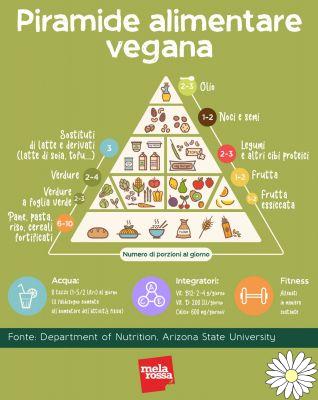
In the table we illustrate, with some examples, which quantities correspond to the portions of each of the food groups included in the vegan food pyramid.
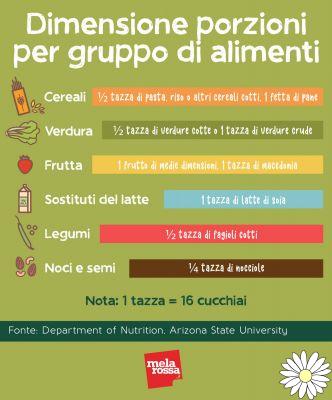
The Spanish vegan food pyramid: the Veg Plate
In Spain, the principles of this diet are summarized by the Vegan plate, vegan food pyramid in the shape of a plate. A diagram that identify the foods that are the basis of a plant-based diet e provides recommendations relating to the specific needs of certain nutrientsi, such as calcium, vitamin D, vitamin B12 and omega 3 fatty acids, to avoid the risk of deficiencies.
As the Scientific Society of Vegetarian Nutrition in the brochure "Let's learn to eat healthy with plant foods”, The VegPlate represents a proposal of Spanish Guidelines for a correct vegetarian diet and a useful scheme for those who want to start following a vegetarian or vegan diet.
According to the indications of the VegPlate, the vegan diet is based on 6 food groupsThese are:
- cereals
- protein foods (legumes and other protein-rich foods, excluding all protein foods of animal origin, i.e. meat, fish, eggs, milk and derivatives)
- vegetables
- fruit
- dried fruit and oil seeds
- grassi.
The 6 food groups of the Plate Veg
Let's see in detail which foods make up the 6 food groups of the vegan food pyramid and which nutrients they provide.
Cereals
This group includes bread, pasta, rice, breakfast cereals, wheat, corn, millet, barley, oats, rye, spelled, buckwheat, kamut, quinoa, bulgur, couscous, rusks, bread sticks and crackers. Rice milk also belongs to the group of cereals. According to the indications of the VegPlate, every meal is built around a nice plate of cereals, preferably whole grains, rich in fiber, complex carbohydrates, proteins, vitamins B, E, iron and zinc.
Foods rich in protein
Among the protein-rich foods there are legumes, all soy-based products (soy milk and yogurt, tofu, tempeh, restructured vegetable proteins) and wheat gluten (seitan) and their combinations (burgers and vegetable meatballs , vegetable cold cuts, etc.). In addition to proteins, these foods also provide minerals, fiber, vitamins and essential fatty acids.
Vegetable
It is important to include large portions of vegetables in the vegan diet, varying them as much as possible: they represent a source of vitamin C, beta-carotene, lycopene, iron, calcium and fiber. Particularly rich in these nutrients are dark green leafy vegetables and cruciferous vegetables (broccoli, cabbage, cauliflower).

Fruit
Fruit is rich in fiber, vitamin C and beta-carotene. According to the Vegan Plate, those who follow a vegan diet should eat at least one portion a day of fruit rich in vitamin C (citrus fruits, melons, strawberries), preferring whole fruit to juices, which lose much of the fiber content of the fruit.
Dried fruit and oil seeds
The vegan diet must also include dried fruit (walnuts, hazelnuts, almonds, etc.) and oil seeds, such as those of pumpkin, sesame, sunflower, flax, which have nutritional characteristics similar to those of dried fruit.
Grassi
This group includes a number of high-calorie foods that are good to consume in moderation. Among these, the oli: it's important favor those of linseed and olive, sources of polyunsaturated fatty acids of the omega 3 family and monounsaturated respectively.
Put your grassi solidi at room temperature (such as tropical coconut and palm oils and margarines) contain instead high amounts of saturated or transhydrogenated fats that are harmful to health and must therefore be used in a very limited way, and only if indispensable.
Veg Platter: the portions of the various foods
For each food group, VegPlate also indicates what a portion corresponds to. The minimum number of portions to consume instead depends on the individual daily calorie requirement.
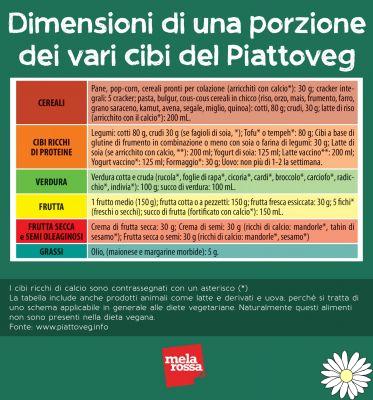
The nutrients to be included in the vegan diet: the recommendations of the Veg Plate
Soccer
They are rich in calcium the foods of the first 5 groups: at least 6 portions a day they should come from this sort of cross-sectional group that includes all 5 of them, to ensure the right calcium intake.
Vitamin D
Vitamin D should be preferably taken as a supplement, in the recommended doses.
Vitamin B12
Vitamin B12 is present only in foods of animal origin, so a vegan diet will have to include the use of fortified plant foods or supplementsi.
Dosages and methods of supplementation must be defined on the basis of personal needs with the help of a doctor or a nutrition specialist.
Omega fatty acids 3
The vegan diet must include 2 portions of foods every day that provide omega-3 fatty acids (legumes, nuts and fats).
The discretionary calories
The VegPlate also provides a quota of "discretionary" calories, that is calories that do not necessarily have to provide nutrients. They can therefore be represented by the so-called "empty calories”, For example processed foods such as snacks and sweet drinks. However, it is preferable to obtain this portion of calories from healthy foods belonging to the VegPlate.
Vegan diet: the benefits
Many researches have highlighted the health benefits associated with a vegetarian-style diet, both in a broader sense, i.e. based on the sole exclusion of meat and fish, and in a more strict sense, i.e. based on the elimination of all products. of animal origin and their derivatives.
Let's see the main ones.
Cardiovascular health
The vegan diet helps to keep cholesterol and triglyceride levels in the normal range, thus reducing the risk of atherosclerosis and cardiovascular disease. These beneficial effects are related to the fact that plant foods are typically low in saturated fat and totally cholesterol-free, which are the dietary factors responsible for increasing blood cholesterol levels. These benefits are therefore common to vegetarians and vegans, but vegans follow a virtually cholesterol-free diet, as this fat is only found in animal foods such as meats, dairy products and eggs.
Reduction of blood pressure values
Many studies, starting from the 20s, have shown that a vegetarian diet is associated with lower blood pressure levelsi.
Control of diabetes
The most recent diabetes studies show that a diet rich in complex carbohydrates (found only in plant foods) and low in fat it is the best dietary prescription for the control of this pathology. A diet based on vegetables, legumes, whole grains and fresh and dried oleaginous fruit, naturally reduced in fat and simple sugars, is able to significantly lower blood glucose levels and often reduce or even eliminate the need for antidiabetic drugs.
A particularly significant effect in the case of type 2 diabetes, but also useful in type 1 diabetes: this type of diet can in fact allow to reduce insulin requirements. The positive effects of a plant-based diet in preventing cardiovascular disease are also beneficial for those suffering from diabetes, because diabetics usually have a high risk of developing these diseases.
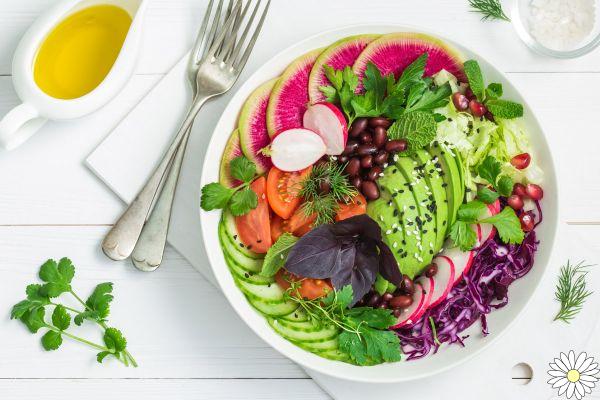
Cancer prevention
Plant-based diets can help prevent some types of cancer. The breast cancer, for example, it has a significantly reduced incidence in those countries where diets are typically based on plant foods. The same risk reduction effect is found for i colorectal cancers, because the high consumption of fibers guarantees good intestinal transit and prevents potentially dangerous substances from remaining in contact with the walls of the intestine for too long.
At the origin of the anticancer action of plant-based diets is the fact that they are low in fat, but also rich in fruits and vegetables that allow to increase the intake of antioxidants, such as beta-carotene and lycopene, associated with reduced rates of lung and prostate cancer. Some studies suggest that diets that limit or completely eliminate milk products can reduce the risk of prostate and ovarian cancer.
Among other benefits, the CREA also points out that the vegan diet:
- ensures a greater sense of satiety than the omnivorous one
- represents an aid to counteract constipation
- favors theincreased intake of folic acid, vitamin C, vitamin E, potassium, magnesium
- can reduce the symptoms of some allergic manifestations such as asthma and atopic dermatitis.
Vegan diet: i rischi
Together with CREA, we also examine the main criticisms leveled at this diet model.
Energy supply
Plant foods are, for the most part, low calorie sources, so the vegan diet can determine insufficient coverage of energy needs, which is particularly risky in subjects of developmental age, in pregnant and lactating women, in individuals who practice sports, especially at a competitive level.
Protein intake
The vegan diet provides not excellent biological value proteins, therefore, if the right combinations are not made between the different plant foods, which are poor in one or more essential amino acids (those that our body cannot produce on its own and must derive from food), a amino acid deficiency which prevents the regular and sufficient development of protein synthesis.
Lipid contribution
In the face of a reduced intake of saturated fatty acids, the vegan diet can include some types of oils, such as palm and coconut oils, which have a high atherogenic power, that is, they can favor the appearance of atherosclerotic lesions which represent a risk factor for cardiovascular diseases and stroke.
Carbohydrate intake
The vegan diet is based on foods that provide simple and complex sugars such as cereals, legumes, tubers, fresh and dried fruit, but what characterizes it is thehigh amount of non-digestible carbohydrates.
Lack of micronutrients
The vegan diet is deficient in B vitamins, iron, calcium, vitamin D, zinc. In pregnant and lactating women, hypovitaminosis can also have repercussions on the health of the baby. At the origin of the deficiencies there are also problems of malabsorption: as regards iron, for example, plants contain it in the non-heme form, which compared to the heme, typical of foods of animal origin, is less bioavailable and therefore less assimilable by the body.
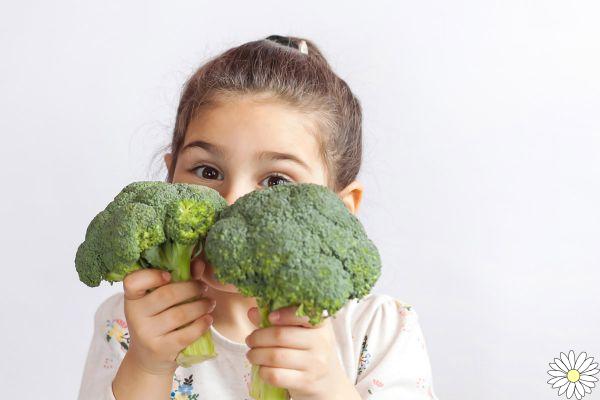
Vegan diet and children
Children, reports the Veronesi Foundation, should not do without derivatives of animal origin, at least in the first 6 years of life. A diet without meat or fish can be followed, always under strict medical supervision, but also giving up milk and eggs can seriously jeopardize their health.
In particular, many studies have shown how adopting a vegan diet (even more so if followed without medical supervision) exposes the child to a widespread lack of nutrients, in particular vitamin B12, calcium, zinc and noble proteins. These deficits can translate into problems like it development of a low-density skeletal system or irreversible neurological disorders. There are also numerous studies that point out that vegan children are thinner and smaller than their omnivorous or vegetarian peers.
Se in adults the choice of a vegan diet is sustainable, in the face of a dietary supplement, the more complex it is to adapt the nutrition of a child who follows a vegan diet: it would therefore be advisable, suggests the Veronesi Foundation, to postpone this choice to the beginning of school age.
Elena Dogliotti, researcher and nutrition biologist at the Umberto Veronesi Foundation says: “A child could also grow up regularly following a vegan diet, but his health should be monitored in a much more stringent way than omnivorous or vegetarian peers do. How? Through the dosage of vitamins, the evaluation of the nutritional status, the monitoring of weight and the quality of muscle mass. All tests aimed at identifying any shortcomings and intervening in a timely manner with adequate supplements ".
“Some parents - explains Dogliotti - are willing to follow this rather complex process. While in all other cases it is better to reason with them and postpone such a choice in order not to put a child's health at risk ”.
Vegan diet in pregnancy and breastfeeding
The same assessment can be extended to pregnant and lactating women. In these delicate moments in a woman's life, when the need for energy and nutrients grows, following a vegan diet can in fact involve risks to the health of the mother and to the development of the child if the diet is not balanced and calibrated on specific and personal needs, supplemented with vitamin B12 and with all the nutrients that the woman may be lacking and followed under the guidance of a gynecologist or a nutrition specialist.
Vegan diet and hyper-healthy extremes
Among the other criticisms leveled at the vegan diet, there is also that linked to the risk that it could lead to hyper-healthy drifts in which the intent to exclude certain foods turns into an obsession: that for a healthy and natural diet that it can take on pathological connotations bordering on eating disorder. The fear is, that is, that veganism, which is based on the rejection of all foods of animal origin and their derivatives, could lead to extremes, such as orthorexia, an eating disorder that consists in the obsessive search for healthy, natural, uncontaminated food.
Of course, we must not think that veganism and orthorexia are synonymous, nor that orthorexia represents a consequence, an automatic and necessary drift, of veganism. Of course, both are based on severe food restrictions and this common element is what leads many to assimilate them, or to consider orthorexia a "side effect" of veganism.
However, there are strong differences between the two: the veganism rests on a free choice, linked to ethical and health reasons, in the case oforthorexiainstead, the obsessive nature of the search for healthy food at all costs takes the form of a eating disorder. A real pathology not linked to cultural practices or ethical reasons (unlike veganism), in which the restrictions become more and more stringent and one gets to lose sight of the danger of nutritional deficiencies, to the point of seriously putting one's health at risk and isolating oneself from the rest of the world to avoid all those situations that could hinder or compromise one's own health. food choice.
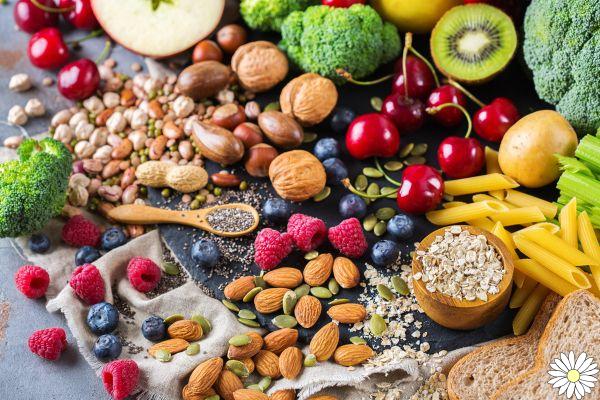
Vegan diet: can it be nutritionally balanced?
These criticisms are counterbalanced by studies that underline that a vegetarian diet, which is widely understood that "total", ie vegan, can be a healthy diet if nutritionally well balanced.
The position of the American Dietetic Association
The Scientific Society of Vegetarian Nutrition reports, for example, the position ofAmerican Dietetic Association e dei Dietitians of Canada.
"The American Dietetic Association and the Dietitians of Canada affirm that properly balanced vegetarian diets are healthy, adequate from a nutritional point of view, and that they have health benefits in the prevention and treatment of certain diseases" also specifying that a vegetarian diet , "Understood as both lacto-ovo-vegetarian and vegan, is able to meet current recommendations for key nutrients such as protein, iron, zinc, calcium, vitamin D, riboflavin, vitamin B12, vitamin A, omega-3 fatty acids and iodine ".
What to do then? The central crux of the question revolves precisely around the concept of "properly balanced diet".
Both the proponents of the vegan diet and those who criticize it agree on one point: theimportance, for those who want to follow this diet, to balance the intake of calories and nutrients very accurately and to provide for the appropriate supplements, contacting a doctor or a nutritionist especially if it falls into categories for which a nutritional deficiency would represent a particularly serious danger (pregnant women, children).
The position of CREA
It is important, underlines CREA, do not ignore the potential deficiency risks associated with the vegan diet, carefully weigh the health benefits and dangers of this diet and, if you decide to adopt it, follow specific nutritional indications.
"Evaluating the nutritional adequacy of the various models of vegetarian nutrition is a very complex task that must take into consideration the pros and cons of a diet that eliminates one or more food groups and, therefore, specific and fundamental nutrients for good health of nutrition and health. Therefore, even very serious nutritional deficiencies can arise ".
A voice joined by that of the Veronesi Foundation, which specifies:
“Veganism is a form of nutrition that needs special attention with regards to the daily balance of nutrients and an appropriate one supplementation with vitamin B12 and possibly calcium ".
Plant-based diets: the recommendations of the Spanish Society of Human Nutrition
Also the SINU (Spanish Society of Human Nutrition) emphasizes the importance of the correct balance of nutrients and the need to take precautions, also providing for additions. Particular attention, he stresses, must be paid "to some key nutrients, which may not always be present in adequate quantities in some types of vegetarian diets".
The key nutrients to balance properly
- Protein: since the digestibility of vegetable proteins is lower than that of animal proteins, it may be advisable for vegetarians to consume a slightly higher amount of protein (5-10%) than what is suggested for the general population.
- Vitamin B12: All people following a vegetarian diet should supplement their diet with a reliable source of vitamin B12 (fortified foods or supplements).
- Soccer: vegetarians, given the exclusion from the diet of animal sources of calcium (milk and derivatives), should pay particular attention to the consumption of vegetable food products that are good sources of calcium (vegetables, such as Cruciferae, low in oxalates and phytates, substances that hinder the absorption of this mineral; soy-based foods; fortified vegetable drinks; waters rich in calcium and some types of nuts and oil seeds).
- Iron: Vegetarians should increase their iron intake compared to omnivores by following a varied diet that includes plant foods with high iron content.
- Zinc: Vegetarians should increase zinc intake from what is recommended for the general population, especially when the phytate / zinc molar ratio of the diet is high (again because phytates can reduce the absorption of this mineral).
- Omega 3 fatty acids: Vegetarians can improve their nutrition status regarding omega 3 fatty acids by regularly taking good sources of alpha linolenic acid (e.g. walnuts, flax and chia seeds, derived oils) and by reducing sources of linoleic acid (for example, vegetable oils such as corn oil and sunflower oil).
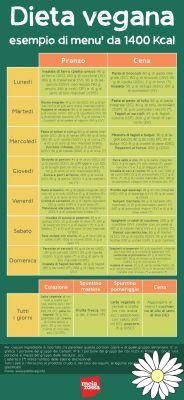
Example of a vegan diet
We offer you an example of a weekly vegan diet based on VegPlate. It is a 1400 kcal menu, therefore of a low-calorie vegan diet, which includes the following portions of the food groups provided by the VegPlate:
- Cereals: 7
- Foods rich in proteins: 3
- Vegetables: 6
- Fruit: 1
- Nuts and oil seeds: 1
- Fats: 1
- Discretionary Calories: 57
If you are looking for other examples of vegan diets, on the website of the VegPlate you will find many menus with different caloric intake.
Vegan diet: the nutritionist's opinion
We asked for an opinion on the vegan diet a Lorenzo Traversetti, OnlyBelleza nutritionist, which warns of the high risk of deficiency associated with this diet.
“Following a vegan diet means preventing our body from receiving some nutrients it absolutely needs to ensure proper functionality of our physiological processes. This is true for an adult but it becomes even more so if children or adolescents follow her. The obligatory use of vitamin B12 supplements is an example of this. It is a key vitamin in regulating the functions of our nervous system: its deficiency, in addition to a general sense of asthenia, could lead to poor attention, neuralgia and migraines ".
"Putting hypothetical ethical motivations before the satisfaction of our physiological needs, in the long run, it risks presenting a fairly salty bill. Unfortunately this account is not evident in the first period in which this diet is followed, as the replacement of animal proteins with vegetable proteins seems to provide the same amount of energy and, at the same time, cause fewer “side effects” (bloating, weight loss, digestive slowdown). However, I reiterate that the effect of nutritional deficiencies, often, can manifest itself in the long term and risks, in this case, to be difficult to reverse".
"Yes to a reduced consumption of animal proteins, but in line with the Mediterranean diet"
"I fully agree - specifies the nutritionist Traversetti - with the need to limit the abuse of proteins of animal origin to which a very large number of people resort and I underline that a vegetarian diet, with sporadic additions of lean meat, eggs and low-fat cheeses , represents the main nutritional protocol to follow. But this coincides with the concept of a true Mediterranean diet, in my view the best nutritional approach to be applied to pursue a good general state of health ”.
Vegan diet for weight loss: because OnlyBelleza does not provide it
Among the different types of diets for weight loss, OnlyBelleza does not include a vegan diet. Because? Precisely because, as the nutritionist explained, it is a diet that it cannot be considered nutritionally complete but which, on the contrary, exposes to a strong risk of deficiencies.
Following a vegan diet requires exceptional attention and care of nutrition, necessarily enriched by commercial additions, which only a doctor can provide based on the evaluation of the patient's complete clinical picture.
For these reasons, the OnlyBelleza diet is available in the omnivorous and in the lacto-ovo-vegetarian version, which allow you to ensure a complete and nutritionally balanced diet according to the principles of the Mediterranean diet, universally recognized as the best for keeping fit and healthy. health.
If you want to know more about the OnlyBelleza diet and request a personalized menu tailored for you, read our article "OnlyBelleza diet: the guide to register".

























